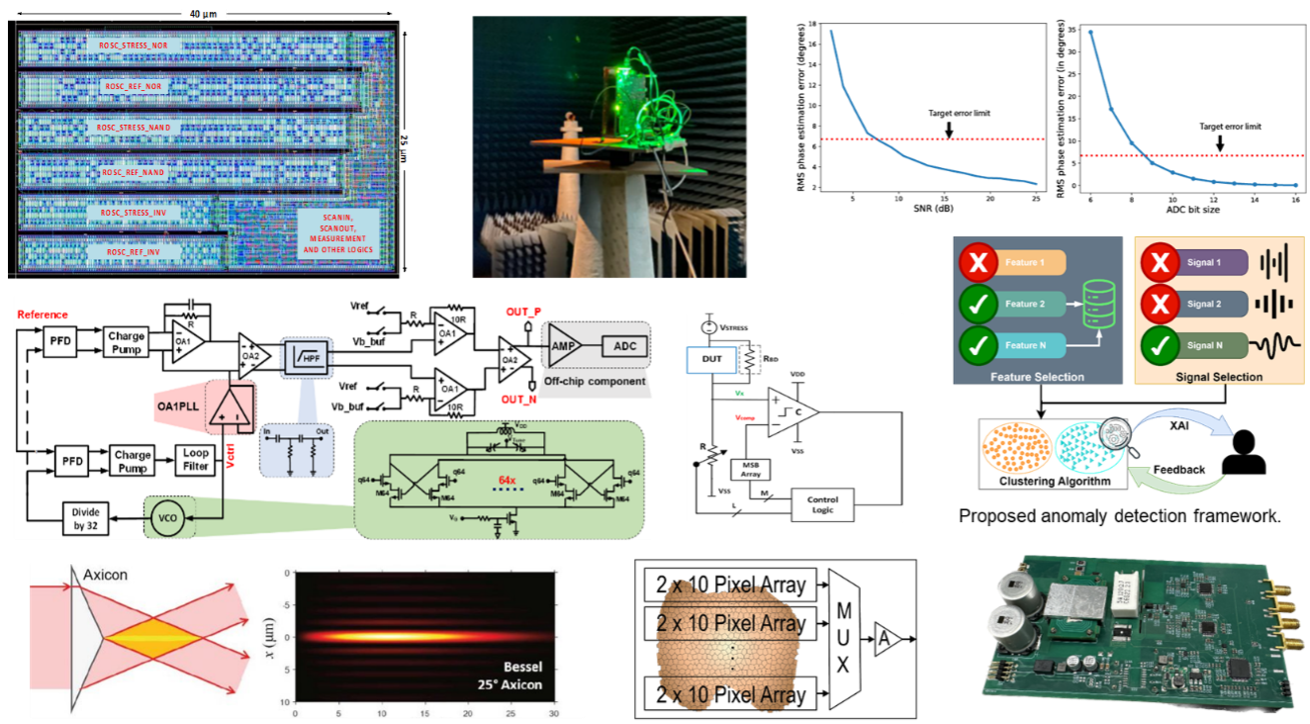Safety, Security, and Health Care
(Thrust leader: Yiorgos Makris, University of Texas at Dallas)
The efforts in the Safety, Security, and Health care thrust focus on improving safety by mitigating various reliability threats in analog/RF devices, including manufacturing defects, process variation, ESD and thermal degradation, as well as by developing effective machine learning-based design, verification and self-test solutions for mixed-signal automotive ICs. Particular emphasis has been placed on characterizing circuit aging, predicting failures and increasing lifetime of nano-scale CMOS circuits. An array of approaches is being developed for in-field detection and localization of both hard and soft analog faults, as well as for low-cost design, test and calibration of RF MIMO systems. Machine learning assisted Design-for-Test solutions as well as inductive fault analysis schemes for statistically characterizing effectiveness of test suites through analog test metrics are also being developed for analog/RF ICs, including DACs. Additionally, this thrust investigates G-Band CMOS mmWave imagers and sensors for biomedical applications and IR gas sensors, as well as methods for analyzing reliability and monitoring the condition of GaN HEMTs. Lastly, this thrust investigates methods for motor health monitoring, laser systems for creating single-event effects that can be used to study radiation tolerance, as well as efficient temperature sensors for thermal performance characterization in power ICs.

Safety, Security and Health Care Thrust
| Category | Accomplishment |
|---|---|
| Safety, Security and Health Care (CADT) | A cost-effective DfT (Design for Testing) method for improving LRFS (Lifetime Reliability and Functional Safety) of analog and mixed-signal circuits has been demonstrated. A concurrent sampling strategy was developed for simultaneous multi-analog-node online measurements. The method was incorporated with a digital-like DfT method and implemented with a PCB demo design. Low-cost SAR ADC defect-oriented test achieved 100% defect coverage by re-using existing digital circuitry. (2810.047, D. Chen, U of Iowa) |
| Safety, Security and Health Care (Circuits) | STEM images of commercially available p-GaN E-mode HEMTs are captured with in-situ bias for electrical stress. The samples with a gate-drain structure were prepared using FIB and e-chip. Leakage current was reduced using plasma and FIB oxide deposition on the samples. This demonstration suggests a potential path for identification of location of initial device failure, and understanding the gate’s multi-stage breakdown paths and the current evolution stages. (2810.057, M. Kim, UT Dallas) |
| Safety, Security and Health Care (Systems) | Miniaturized mid-infrared (IR) sensors operating at room temperature based on ultrathin meta-surfaces integrated within a piezoelectric nanomechanical resonator system (MEMS), optimized for gas sensing are demonstrated. Thousands of such sensors were tested to characterize their responsivity and noise. Outstanding NEP (noise equivalent power) of 80pW/√Hz at room temperature, drastically outperforming the state-of-the-art is achieved. (2810.050, S. Gomez Diaz, UC Davis) |
